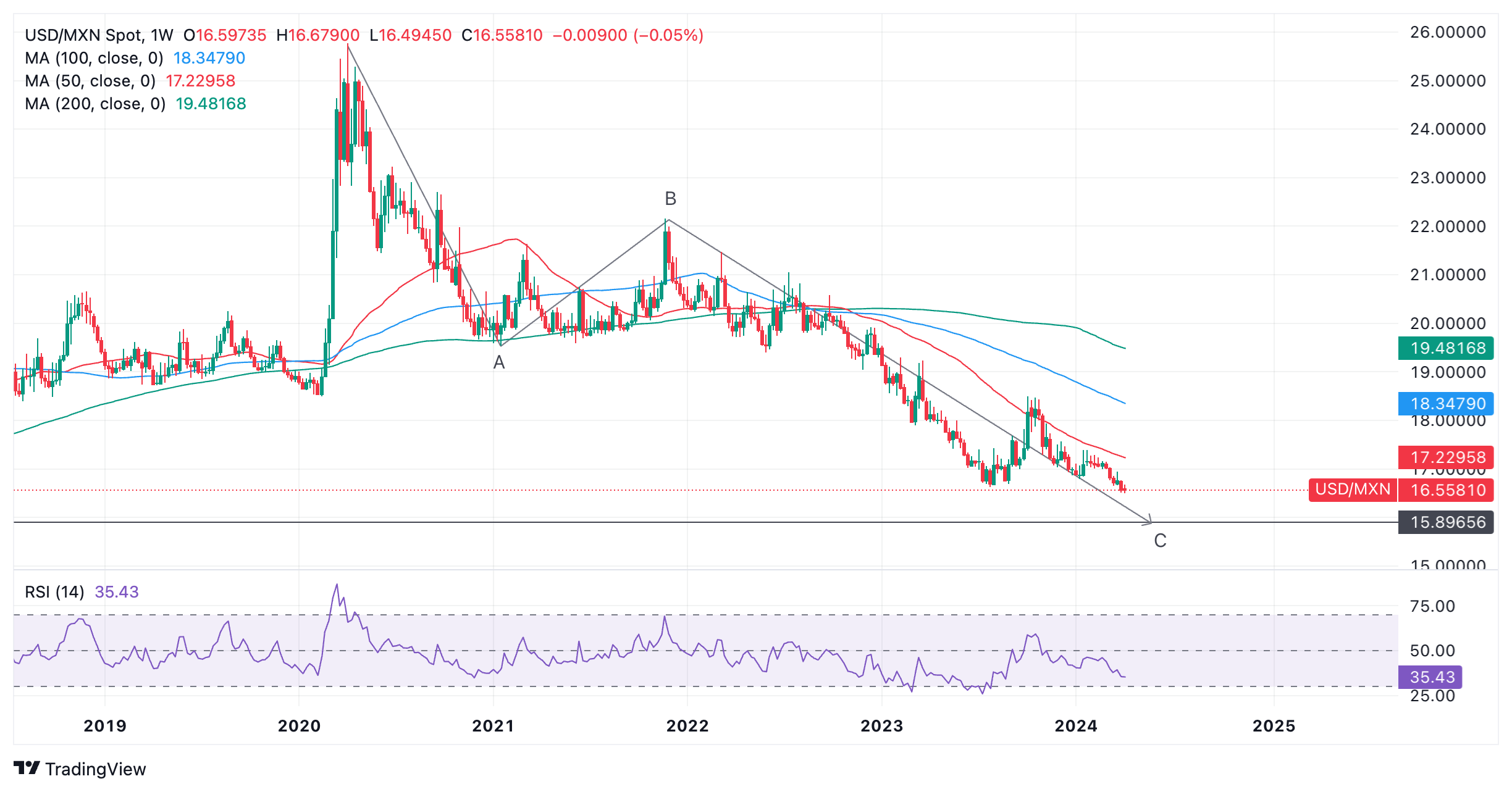- The Mexican Peso rises to a nine-year high versus USD on Friday.
- The release of Banxico’s March meeting minutes may have helped spur the Peso to more gains.
- Higher crude Oil prices, a key Mexican export, could also be supporting MXN.
The Mexican Peso (MXN) trades at nine-year highs against the US Dollar (USD) on Friday despite a slight pullback following the release of better-than-expected US Nonfarm Payrolls data that supported its key counterpart, the USD.
The Mexican Peso’s broad gains come after the release of the Banco de Mexico’s (Banxico) March meeting minutes and amid a rise in Crude Oil prices, a key export for Mexico.
The Banxico minutes revealed a reluctance from some policymakers to embrace a cycle of easing, including a commitment to lowering interest rates in the future, due to continued stubborn inflation.
The prospect of interest rates remaining high in Mexico – they are currently at 11.00% – supports the Mexican Peso as it leads to higher foreign capital inflows.
Higher crude Oil prices, with Brent crude Oil pushing above $90 a barrel on Friday, may also have helped the Mexican Peso, given its importance as an export.
US Nonfarm payrolls (NFP) data, meanwhile, only provided temporary support to USD/MXN – the number of Pesos that can be bought with one US Dollar – after it showed an unexpected rise of 303,000 people in work in March when economists had only expected 200,000. In addition, the data showed a fall in the US Unemployment Rate to 3.8% from 3.9% when no-chnage had been expected.
The data further brings into question whether the federal Reserve will cut interest rates in June as previously expected.
Mexican Peso supported by hawk found in Banxico
The Mexican Peso finds support and recovers after the release of the minutes of the Banxico March meeting.
Although the majority of members voted to cut interest rates by 0.25% to 11.00%, one policymaker, Irene Espinosa, voted against the cut.
Key takeaways:
- In summary, the minutes highlighted how inflation, particularly in the services sector, remained stubbornly high and interest rates would therefore need to stay elevated to bring it back down to the bank’s 3.0% target.
- Members considered that the balance of risks for the trajectory of inflation within the forecast horizon remains biased to the upside.
- It was acknowledged that although inflation remained sticky the current environment was less adverse than that faced in 2022 and the first months of 2023.
- Members observed that long-term inflation expectations drawn from the survey conducted by Banco de México remain anchored at 3.5% – above Banxico’s 3.0% target.
- It was agreed that monetary policy should remain restrictive and therefore conducive to the convergence of inflation to the 3% target in the forecast horizon.
- Future decisions will be data-dependent.
- One member noted that “despite monetary restriction, domestic economic activity continues showing resilience and that demand-related pressures may slow down or even reverse the fall in inflation.
- Further, it was noted that “economic activity continues exhibiting dynamism despite the historical increase in the real interest rate.”
Mexican Peso sensitivity to risk aversion
According to commentary from one member of Banxico, data from the foreign exchange derivatives market show that the Mexican Peso is biased to depreciate.
MXN is also particularly sensitive to depreciating during periods of high risk aversion, the Banxico meeting minutes said.
“The reduction in exchange rate volatility and in the implied skew in foreign exchange options suggest a lower demand for hedging amid a possible depreciation of the Mexican peso, which contrasts with other election years,” said the member, who was not named.
“Lower demand, as well as the positioning observed in short-term foreign exchange derivatives markets, could magnify a depreciation of the Mexican Peso in the event of an episode of high-risk aversion, and thus periods of volatility cannot be ruled out,” the member added.
Technical Analysis: USD/MXN in long trend lower
USD/MXN is in a long-term downtrend that is exhibiting signs of waning pressure. The bear trend started after the pair peaked at 25.76 in April 2020 – we are now in the 16.50s.
It is possible the pair is unfolding a very large three-wave pattern called a Measured Move. Such patterns are composed of an A, B, and C wave, with wave C extending to a similar length to wave A, or a Fibonacci 0.618 ratio of A.
USD/MXN Weekly Chart
If this is the case, price has almost reached the point at which C will equal A, calculated as lying at 15.89.
It has also by now surpassed the conservative target for the end of C at the 0.618 Fibonacci extension of A (at 18.24).
Once the pattern is complete the market usually reverses or undergoes a substantial correction.
The Relative Strength Index (RSI) is converging acutely with price – a sign the downtrend could be losing momentum. In 2024 price has pushed below the level of the 2023 lows but RSI has not followed suit. This non-correlation between price and momentum is a bullish indication. It could lead to a correction higher eventually.
There has been no reaction from price yet, however, so the expectation of upside remains speculatory and unconfirmed.
An actual turnaround in the price would be required to support the view a change is on the horizon, and that is still lacking.
Banxico FAQs
The Bank of Mexico, also known as Banxico, is the country’s central bank. Its mission is to preserve the value of Mexico’s currency, the Mexican Peso (MXN), and to set the monetary policy. To this end, its main objective is to maintain low and stable inflation within target levels – at or close to its target of 3%, the midpoint in a tolerance band of between 2% and 4%.
The main tool of the Banxico to guide monetary policy is by setting interest rates. When inflation is above target, the bank will attempt to tame it by raising rates, making it more expensive for households and businesses to borrow money and thus cooling the economy. Higher interest rates are generally positive for the Mexican Peso (MXN) as they lead to higher yields, making the country a more attractive place for investors. On the contrary, lower interest rates tend to weaken MXN. The rate differential with the USD, or how the Banxico is expected to set interest rates compared with the US Federal Reserve (Fed), is a key factor.
Banxico meets eight times a year, and its monetary policy is greatly influenced by decisions of the US Federal Reserve (Fed). Therefore, the central bank’s decision-making committee usually gathers a week after the Fed. In doing so, Banxico reacts and sometimes anticipates monetary policy measures set by the Federal Reserve. For example, after the Covid-19 pandemic, before the Fed raised rates, Banxico did it first in an attempt to diminish the chances of a substantial depreciation of the Mexican Peso (MXN) and to prevent capital outflows that could destabilize the country.
Information on these pages contains forward-looking statements that involve risks and uncertainties. Markets and instruments profiled on this page are for informational purposes only and should not in any way come across as a recommendation to buy or sell in these assets. You should do your own thorough research before making any investment decisions. FXStreet does not in any way guarantee that this information is free from mistakes, errors, or material misstatements. It also does not guarantee that this information is of a timely nature. Investing in Open Markets involves a great deal of risk, including the loss of all or a portion of your investment, as well as emotional distress. All risks, losses and costs associated with investing, including total loss of principal, are your responsibility. The views and opinions expressed in this article are those of the authors and do not necessarily reflect the official policy or position of FXStreet nor its advertisers. The author will not be held responsible for information that is found at the end of links posted on this page.
If not otherwise explicitly mentioned in the body of the article, at the time of writing, the author has no position in any stock mentioned in this article and no business relationship with any company mentioned. The author has not received compensation for writing this article, other than from FXStreet.
FXStreet and the author do not provide personalized recommendations. The author makes no representations as to the accuracy, completeness, or suitability of this information. FXStreet and the author will not be liable for any errors, omissions or any losses, injuries or damages arising from this information and its display or use. Errors and omissions excepted.
The author and FXStreet are not registered investment advisors and nothing in this article is intended to be investment advice.
Note: This article have been indexed to our site. We do not claim legitimacy, ownership or copyright of any of the content above. To see the article at original source Click Here














